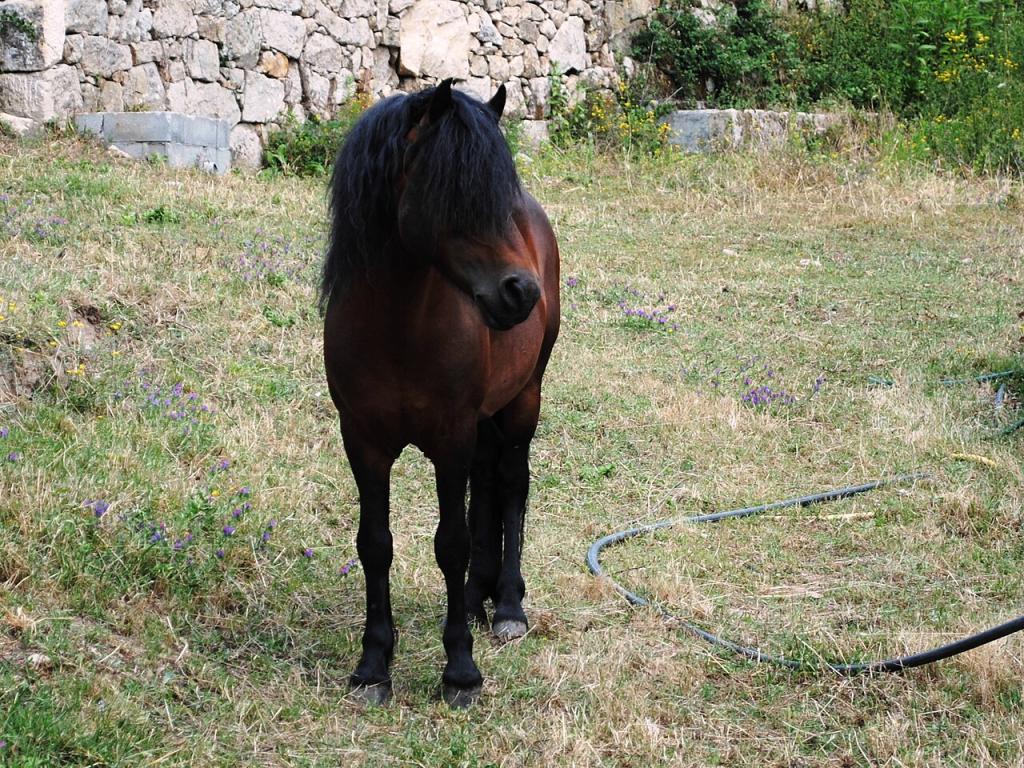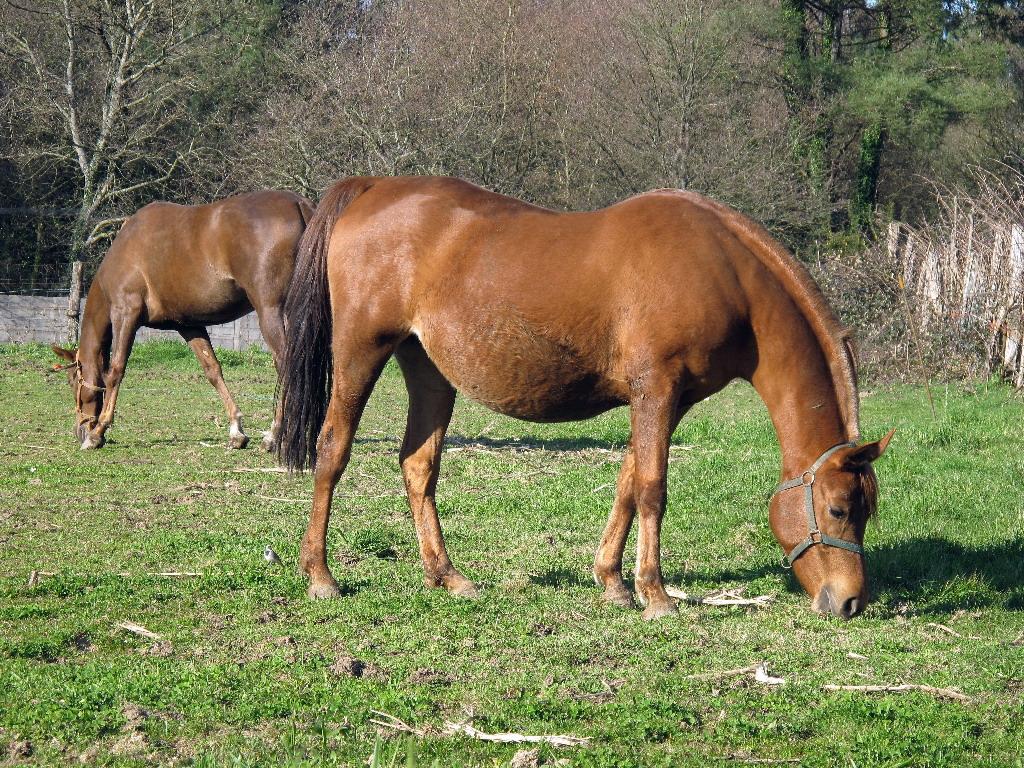
Continent: Europe
Country: Spain
Weight: 300 – 400 kg
Height: 120 – 130 cm

The Gallega horse, or Cabalo de Pura Raza Galega, is a very ancient breed originating from Galicia, in the northwestern part of Spain. Its origin is deeply connected to the natural, cultural, and geographical history of this mountainous Atlantic region.
The Gallega horse likely descends from primitive equine populations that arrived in the Iberian Peninsula during the Upper Paleolithic.
It is considered a direct descendant of small Atlantic Celtic ponies, closely related to breeds such as the Exmoor, Pottok, and the Portuguese Garrano.
These horses survived for millennia in the Galician mountains, a harsh and humid environment, with minimal crossbreeding, preserving their original characteristics.
Similar horses appear in prehistoric rock carvings found in the region and are mentioned in medieval documents as being light, hardy mounts.
Historically, Galician horses were used by peasants for agricultural work, but also in religious processions and traditional festivals such as the curros, where semi-wild horses are rounded up once a year.
In the 20th century, the breed faced extinction, threatened by agricultural mechanization, deforestation, and uncontrolled crossbreeding.
Conservation efforts began in the 1980s, leading to the creation of an official studbook in 1998 to preserve the pure lineage of the breed.
The Gallega breed is primarily found in Galicia, in mountainous and rural areas where extensive and semi-wild breeding remains a living tradition.
The horses often live freely in forests and mountain ranges, with annual gatherings known as curros, during which herds are rounded up for management and identification.
A conservation-based breeding program has also been established in cooperation with the Asociación Pura Raza Cabalo Galego, to preserve the genetic purity of the breed. These horses are also involved in ecological restoration and wildfire prevention projects, due to their ability to graze undergrowth in wooded areas.
Geographic distribution:
- Province of Lugo: Montes de O Xistral, Serra do Courel, Ancares mountains
→ Significant presence of semi-wild populations.
- Province of Ourense: A Serra de Queixa, Macizo Central
→ Extensive breeding and traditional pastoralism remain in practice.
- Province of Pontevedra: Suído and Cando massifs
→ Used for pasture management in extensive grazing systems.
- Province of A Coruña: Low-density rural areas
→ Less widespread but still present.
The Gallega horse (Cabalo de Pura Raza Galega) holds major genetic importance, both regionally and internationally, due to its role in biodiversity, rusticity, and the conservation of primitive equine breeds.
The Gallega is one of the oldest horse breeds in Western Europe, having avoided crossbreeding with large modern industrial bloodlines.
It retains morphological and genetic traits similar to those of ancient Celtic ponies, such as the Exmoor and the Garrano.
Its unique genetic heritage reflects a long natural evolution in rugged mountain environments.
Thanks to its natural hardiness, endurance, disease resistance, and fertility in harsh conditions, the Gallega horse represents a valuable genetic resource for breeding programs and environmental resilience. It adapts well to extensive farming systems, including those in remote or low-mechanized regions.
In a global context where many horse breeds have become standardized or over-crossed, the Gallega offers a reservoir of genetic diversity, useful for:
- the reconstitution of hardy populations,
- biodiversity conservation programs,
- and comparative genetic research.
The breed also serves as a living symbol of Galician heritage, deeply rooted in the region’s rural traditions.
Protecting it also contributes to the preservation of local ecosystems, particularly forest and mountain pastures.
An Ancient Breed Rooted in Galicia :
The Gallega horse, or Cabalo de Pura Raza Galega, is a living heritage deeply rooted in the culture, geography, and rural traditions of Galicia, in northwestern Spain. It is considered one of the oldest equine breeds on the Iberian Peninsula.
Prehistoric Origins :
The origins of the Gallega go back to the Upper Paleolithic, a time when wild horses already roamed the region. It likely descends from Atlantic Celtic ponies, closely related to the Portuguese Garrano, the Asturcón, and the Exmoor pony, with which it shares a rustic build and excellent adaptation to steep, rugged terrain.
Survival in the Wild Mountains :
Over the centuries, the Gallega has been maintained in semi-wild conditions in Galicia's forests and mountains, allowing it to retain its primitive traits: small size, hardiness, frugality, and stamina.
The Horse of the Celts and Romans :
During the time of the Celtic tribes of Galicia, these horses were used in warfare, transport, and religious rituals. Roman texts already described small, lively, and resilient horses in the region of Gallaecia, strongly resembling the modern Gallega.
A Working Horse Through the Centuries :
From the Middle Ages to the 20th century, the Gallega horse played a central role in Galician rural life. It served as a light riding horse, a pack animal, and a farm helper, especially in mountainous areas where larger horses were impractical.
A Sharp Decline in the 20th Century :
With the advent of agricultural mechanization, the breed fell into disuse. Many horses were sold, crossbred, or slaughtered for meat, leading to a dramatic population collapse in the 1970s and 1980s, threatening the breed’s very existence.
The Revival of an Equine Heritage :
In response, local breeders and heritage advocates launched a conservation movement in the 1990s. In 1997, the Asociación Pura Raza Cabalo Galego was founded, and in 1998, the official studbook was recognized by the Xunta de Galicia, marking the official rebirth of the Gallega breed.
The Gallega horse (Cabalo de Pura Raza Galega) is known for its rustic, independent, and resilient nature, shaped by centuries of life in mountainous and natural environments. Its personality is closely tied to its traditional semi-wild way of life.
- Autonomous and alert: Accustomed to surviving in semi-freedom, it knows how to fend for itself, forage for food, and avoid natural dangers.
- Herd-oriented: It typically lives in small, tightly structured family groups with clear and stable hierarchies.
- Curious but cautious: It shows interest in humans but remains distant if not handled from a young age.
- Balanced and calm when properly trained.
- Mentally strong, well-suited to challenging environments.
- Brave and enduring, capable of covering long distances and navigating difficult terrain.
While individuals raised in the wild may display stubbornness or independence, the Gallega usually becomes gentle and easy to handle when accustomed to human contact from an early age. Without proper training, however, it can be challenging for novice riders. On the other hand, once well-trained, it makes an excellent partner for outdoor activities, especially in mountainous landscapes.
"Small in size, great in spirit, the Gallega embodies the wild freedom of Galicia’s mountains."
The Gallega horse, a true emblem of rural Galician culture, is now experiencing a renewed interest in conservation, cultural heritage promotion, and sustainable use. Despite these efforts, the breed remains threatened, and its future depends on a complex mix of environmental, social, and economic factors.
Officially recognized as a breed at risk of extinction, the Gallega is the focus of a rigorous selection program, overseen by the official studbook and the Asociación Pura Raza Cabalo Galego. The Xunta de Galicia also supports public initiatives aimed at maintaining purebred reproductive populations, avoiding uncontrolled crossbreeding, and ensuring sufficient genetic diversity.
From an ecological perspective, the Gallega plays an increasing role in eco-pastoral systems. These horses contribute to landscape management, wildfire prevention, and vegetation control in remote or hard-to-reach areas. Such ecosystem services may eventually justify increased European support, notably through the Common Agricultural Policy (CAP).
The curros traditional roundups of semi-wild horses held once a year help maintain Galician cultural identity and raise awareness of the breed. In parallel, the development of ecotourism and trail-riding activities involving these hardy horses offers new economic opportunities for local breeders.
However, several threats remain. Rural depopulation leads to a loss of traditional knowledge and the gradual abandonment of farmland. Economic pressures also weigh heavily on small-scale breeders, who often face high maintenance costs without sufficient commercial return.
Lastly, extreme weather events, particularly wildfires, pose a growing risk to free-roaming horse populations in forested and mountainous areas.
The Gallega horse (Cabalo de Pura Raza Galega) is renowned for its robust health and strong natural resistance, shaped by centuries of survival in the harsh conditions of the Galician mountains.
- Exceptional hardiness: This breed is well adapted to humid, windy, and cold climates typical of Galicia.
- Excellent resistance to parasites, skin infections, and humidity-related respiratory illnesses.
- Fully outdoor lifestyle: capable of living outside year-round, finding natural shelter in forests or among rocks.
Gallega horses often live well beyond 25 years.
Mares show high fertility, even in extensive or semi-wild systems.
Foals are usually born without complications and display a strong natural survival instinct.
They require very little concentrated feed: Gallega horses thrive on poor pastures, shrubs, and native vegetation.
Their hooves are tough and durable, rarely requiring shoeing, and are well suited to rocky terrain.
In semi-natural systems, they rarely need veterinary care, aside from basic routine checks (deworming, dental care, etc.).
However, they may be at risk of nutritional distress if natural resources are insufficient or if overpopulation occurs on limited land.
Some individuals raised in the wild may also be more difficult to handle for veterinary procedures if not accustomed to human contact.
Born on 01/01/1990
- One of the first stallions registered in the official studbook in the late 1990s
- Used as a reference sire by the Asociación Pura Raza Cabalo Galego
- Symbol of the early stages of the genetic conservation program